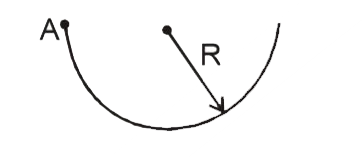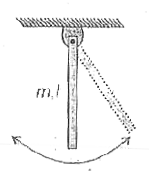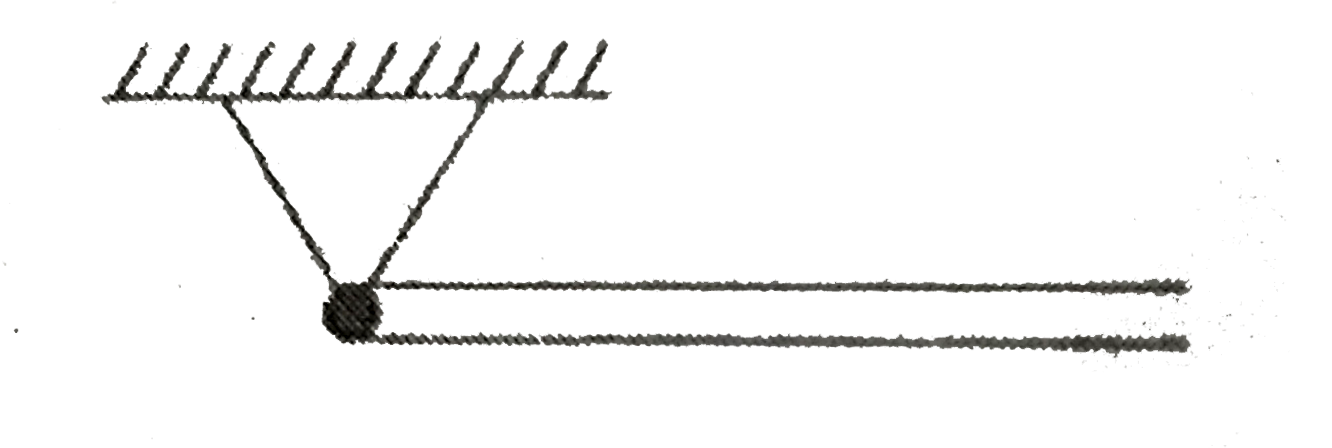A rod of uniform cross-section of mass M and length L is hinged about an end to swing freely in a vertical plane. Howerver, its density is non uniform and varies linearly from hinged end to the free end doubling its value. The moment of inertia of the rod, about the rotation axis passing through the hinge point
2ML29
3ML216
7ML218
none of these
To find the moment of inertia of a rod with non-uniform density, we can follow these steps:
Step 1: Define the Problem
We have a rod of length L and mass M that is hinged at one end. The density of the rod varies linearly from the hinged end to the free end, doubling its value. We need to find the moment of inertia about the hinge point.
Step 2: Express the Density Function
Let the density at the hinged end be ρ0. Since the density doubles at the free end, the density at the free end (at x=L) will be 2ρ0. The linear variation of density can be expressed as:
ρ(x)=ρ0+(2ρ0−ρ0L)x=ρ0+ρ0Lx=ρ0(1+xL)
Step 3: Calculate the Mass of the Rod
The mass M of the rod can be calculated by integrating the density over the length of the rod:
M=∫L0ρ(x)Adx
where A is the cross-sectional area. Substituting ρ(x):
M=∫L0ρ0(1+xL)Adx
Calculating the integral:
M=Aρ0(x+x22L)L0=Aρ0(L+L22L)=Aρ0(L+L2)=3ALρ02
Step 4: Express the Cross-Sectional Area in Terms of Mass
From the previous equation, we can express Aρ0 in terms of M:
Aρ0=2M3L
Step 5: Calculate the Moment of Inertia
The moment of inertia I about the hinge point can be calculated using:
I=∫L0x2dm
where dm=ρ(x)Adx. Substituting for dm:
I=∫L0x2ρ(x)Adx=∫L0x2(ρ0(1+xL))Adx
Calculating the integral:
I=Aρ0∫L0x2(1+xL)dx=Aρ0(∫L0x2dx+1L∫L0x3dx)
Calculating the integrals:
∫L0x2dx=L33,∫L0x3dx=L44
Thus,
I=Aρ0(L33+1L⋅L44)=Aρ0(L33+L34)=Aρ0(4L3+3L312)=Aρ0(7L312)
Step 6: Substitute Aρ0
Now substituting Aρ0=2M3L:
I=2M3L⋅7L312=14ML236=7ML218
Final Result
The moment of inertia of the rod about the hinge point is:
I=7ML218
We have a rod of length L and mass M that is hinged at one end. The density of the rod varies linearly from the hinged end to the free end, doubling its value. We need to find the moment of inertia about the hinge point.
Let the density at the hinged end be ρ0. Since the density doubles at the free end, the density at the free end (at x=L) will be 2ρ0. The linear variation of density can be expressed as:
ρ(x)=ρ0+(2ρ0−ρ0L)x=ρ0+ρ0Lx=ρ0(1+xL)
The mass M of the rod can be calculated by integrating the density over the length of the rod:
M=∫L0ρ(x)Adx
where A is the cross-sectional area. Substituting ρ(x):
M=∫L0ρ0(1+xL)Adx
Calculating the integral:
M=Aρ0(x+x22L)L0=Aρ0(L+L22L)=Aρ0(L+L2)=3ALρ02
From the previous equation, we can express Aρ0 in terms of M:
Aρ0=2M3L
The moment of inertia I about the hinge point can be calculated using:
I=∫L0x2dm
where dm=ρ(x)Adx. Substituting for dm:
I=∫L0x2ρ(x)Adx=∫L0x2(ρ0(1+xL))Adx
Calculating the integral:
I=Aρ0∫L0x2(1+xL)dx=Aρ0(∫L0x2dx+1L∫L0x3dx)
Calculating the integrals:
∫L0x2dx=L33,∫L0x3dx=L44
Thus,
I=Aρ0(L33+1L⋅L44)=Aρ0(L33+L34)=Aρ0(4L3+3L312)=Aρ0(7L312)
Now substituting Aρ0=2M3L:
I=2M3L⋅7L312=14ML236=7ML218
The moment of inertia of the rod about the hinge point is:
I=7ML218
Topper's Solved these Questions
- BOOK - DC PANDEY ENGLISHCHAPTER - ROTATIONAL MECHANICSEXERCISE - Level 1 Subjective32videos
ROTATIONAL MECHANICS
- BOOK - DC PANDEY ENGLISHCHAPTER - ROTATIONAL MECHANICSEXERCISE - Level 2 Single Correct26videos
ROTATIONAL MECHANICS
- BOOK - DC PANDEY ENGLISHCHAPTER - ROTATIONAL MECHANICSEXERCISE - Assertion And Reason11videos
ROTATIONAL MECHANICS
- BOOK - DC PANDEY ENGLISHCHAPTER - ROTATIONEXERCISE - (C) Chapter Exercises39videos
ROTATION
- BOOK - DC PANDEY ENGLISHCHAPTER - ROTATIONAL MOTIONEXERCISE - Integer Type Questions17videos
ROTATIONAL MOTION
Similar Questions
A thin uniform wire of mass m and length l is bent into to shape of a semicircle. The moment of inertia of that wire about an axis passing through its free ends is
View SolutionA uniform rod of mass m is bent into the form of a semicircle of radius R. The moment of inertia of the rod about an axis passing through A and perpendicular to the plane of the paper is
 View Solution
View SolutionA uniform rod of mass m is bent into the form of a semicircle of radius R. The moment of inertia of the rod about an axis passing through A and perpendicular to the plane of the paper is
 View Solution
View SolutionA uniform rod of mass m and length L is hinged about one end and can freely rotate in a vertical plane. The angular velocity of the rod, when it falls from position P to Q. through an angle α starting from rest, is
 View Solution
View SolutionA uniform rod of mass m and length l is suspended about its end. Time period of small angular oscillations is
 View Solution
View SolutionA uniform rod of mass 20 Kg and length 1.6 m is piovted at its end and swings freely in the vertical plane. Angular acceleration of the rod just after the rod is relased from rest in the horizontal position is
 View Solution
View SolutionThe moment of inertia of a thin uniform rod about an axis passing through its centre and perpendicular to its length is I0. What is the moment of inertia of the rod about an axis passing through one end and perpendicular to the rod ?
View SolutionA thin rod of mass m and length l is hinged at the lower end to a level floor and stands vertically. Then its upper end will strike the floor with a velocity given by:
View SolutionA light rod of length l has two masses m1 and m2 attached to its two ends. The moment of inertia of the system about an axis perpendicular to the rod and passing through the centre of mass is.
View SolutionFour identical uniform thin rods, each of mass m and length l are joined to a common point O as shown in the figure. Moment of inertia of the system about an axis passing through O and lying in the plane of rods is
View Solution

